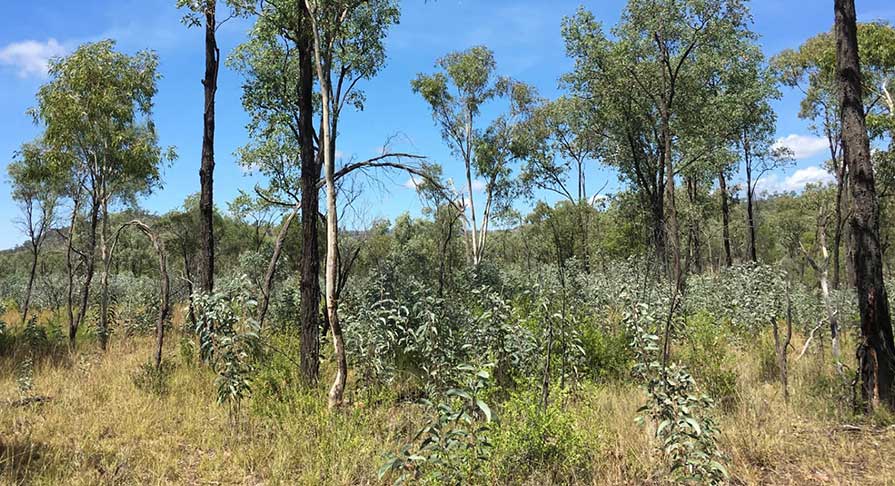Along with raising livestock or growing crops, carbon farming can be integrated into your current farming operation to generate an additional and diversified income stream that supports primary production. When done well, it can even boost your productivity and improve your land health and resilience.
It may sound too good to be true, but the key to a successful project looking holistically at the land and your operation, identifying which potential carbon farming projects would positively impact your property and can align with your long-term farming goals.
What is carbon farming?
At face value, carbon farming is simply adjusting the way you manage your land to prevent the release of greenhouse gas emissions into the atmosphere. It sounds easy, but it can be quite complex. The key is identifying and implementing new and additional practices that hold carbon in vegetation and soils. It can be a single land management change or a whole of farm approach by managing water, plants, and livestock.
Eligible activities that landholders can undertake to produce carbon credits include:
- Changes to livestock management.
- Protecting native vegetation at risk of clearing.
- Regeneration or reforestation of native vegetation.
- Improving soil carbon.
The main goal of carbon farming is reducing the amount of carbon released into the atmosphere, as well as generating a fresh source of income for the landholder.
How do I do it?
There are multiple different farming methods that are available through the Clean Energy Regulator (CER). They range from savanna burning and vegetation management projects to changes in on-farm agricultural systems:
These projects protect areas of growing forest that has been previously cleared from future scheduled clearing.
To be eligible, there must be evidence of two historical clearing events that have occurred where unrestricted clearing was permitted and cropping or grazing has been undertaken after clearing.

The Native Forest from Managed Regrowth method involves changing land management practice to allow native vegetation to grow and become forest by stopping activities that suppress or destroy regeneration of native vegetation on the land. By doing so, it helps to reduce the amount of greenhouse gas entering the atmosphere because carbon is stored, or sequestered in the trees as they grow.
This method involves establishing and maintaining vegetation such as trees or shrubs on land that has been clear of forest for at least five years. It can involve planting a mix of trees, shrubs and understory species native to the local area or species of mallee eucalypts. This practice helps reduce the amount of greenhouse gas entering the atmosphere because carbon is stored in the trees as they grow.
A landholder can earn carbon credits by storing carbon in soil, a process stacked with ecological benefits proven to boost soil quality and therefore, cattle and crop yield. Soil carbon sequestration and regenerative agriculture is seen as one of the most important and cost-effective systems for storing and abating global C02 levels.

Large parts of Northern Australia’s tropical savanna landscapes are susceptible to unplanned wildfires throughout the late dry season. These fires produce more greenhouse gas emissions than managed burns that occur under cooler conditions in the early dry season.
A savanna burning project involves the application of a strategic early dry season burning regime to reduce the risk and extent of late dry season wildfires. This reduces the frequency and extent of these fires, resulting in fewer emissions. Early dry season burning practices can benefit anyone who manages tropical savannas in the north of Australia.

What are the benefits of carbon farming?
There are multiple benefits and rewards associated with carbon farming. They include improving the productivity of land, landscape restoration, less soil erosion, improved climate resilience, better water retention, less salinity, greater ground cover, improved biodiversity, as well as buffering against drought and greater water efficiency.
It can also generate a welcome and profitable source of income to support existing agriculture enterprise.
Landholders are issued with carbon credits for every tonne of CO2e1 sequestered or abated through the project. Those credits are then sold to companies or governments that want to offset their own emissions, generating a new income stream for landholders engaged in carbon farming.
The forecasted value of the carbon market is 40 billion dollars by 2050.
Why work with a developer like GreenCollar?
The key to identifying the best carbon farming methods for your property is to work with a developer who can tailor a carbon farming project to suit your property and align with your goals, balancing agricultural production with real environmental outcomes.
GreenCollar is one of the only operators in Australia with full end-to-end, in-house expertise in the development, management, legal and technical implementation of carbon projects. We are the largest supplier of nature-based carbon credits (ACCUs)to the Australian government and at the forefront of the voluntary market, actively working to generate new demand for our high quality, high integrity ACCUs.
Over the past decade, we have developed hundreds of successful partnerships with farmers, pastoralists and graziers, traditional owners, and other land managers across Australia.
Our carbon farming projects have delivered both on-farm and on-country environmental, social and economic benefits and have helped many landholders stay afloat during hard times.
Undertaking a project with GreenCollar means you get paid for measured and verified environmental outcomes resulting from land management practices that deliver benefits for your business as well as the environment. The money the project brings through the front gate is yours to invest back into your business.
What is the process?
Throughout the project development and 25-year crediting period, GreenCollar manages all ongoing monitoring and reporting, working with you and others to gather information and support on ground management to deliver real, verifiable outcomes. Landholders are responsible for implementation of agreed project activities on-the-ground and supplying relevant information to support project reporting.
Work with us on a carbon farming project
GreenCollar is one of the only operators in Australia with full end-to-end, in-house expertise in the development, management, legal and technical implementation of carbon projects. We are the largest supplier of nature-based ACCUs to the Australian Government and at the forefront of the voluntary market, actively working to generate new demand for our high quality, high integrity ACCUs.








